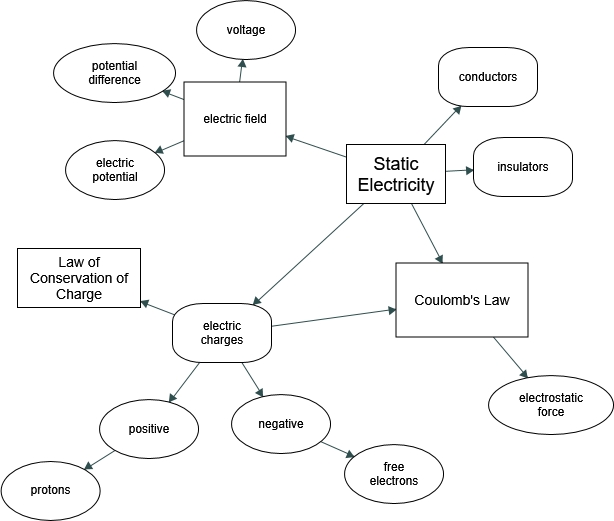12 Main Ideas
Concept Map

Concept Trailer: Electric potential
Concept Trailer: Electric fields
Key Terms
chapter 18
- conductor
- a material that allows electrons to move separately from their atomic orbits
- conductor
- an object with properties that allow charges to move about freely within it
- Coulomb force
- another term for the electrostatic force
- Coulomb interaction
- the interaction between two charged particles generated by the Coulomb forces they exert on one another
- Coulomb’s law
- the mathematical equation calculating the electrostatic force vector between two charged particles
-
- electric charge
- a physical property of an object that causes it to be attracted toward or repelled from another charged object; each charged object generates and is influenced by a force called an electromagnetic force
- electric field
- a three-dimensional map of the electric force extended out into space from a point charge
- electric field lines
- a series of lines drawn from a point charge representing the magnitude and direction of force exerted by that charge
- electromagnetic force
- one of the four fundamental forces of nature; the electromagnetic force consists of static electricity, moving electricity and magnetism
- electron
- a particle orbiting the nucleus of an atom and carrying the smallest unit of negative charge
- electrostatic equilibrium
- an electrostatically balanced state in which all free electrical charges have stopped moving about
- electrostatic force
- the amount and direction of attraction or repulsion between two charged bodies
-
- electrostatic repulsion
- the phenomenon of two objects with like charges repelling each other
- electrostatics
- the study of electric forces that are static or slow-moving
- Faraday cage
- a metal shield which prevents electric charge from penetrating its surface
- field
- a map of the amount and direction of a force acting on other objects, extending out into space
- free charge
- an electrical charge (either positive or negative) which can move about separately from its base molecule
- free electron
- an electron that is free to move away from its atomic orbit
- induction
- the process by which an electrically charged object brought near a neutral object creates a charge in that object
- insulator
- a material that holds electrons securely within their atomic orbits
law of conservation of charge
states that whenever a charge is created, an equal amount of charge with the opposite sign is created simultaneously
- proton
- a particle in the nucleus of an atom and carrying a positive charge equal in magnitude and opposite in sign to the amount of negative charge carried by an electron
- screening
- the dilution or blocking of an electrostatic force on a charged object by the presence of other charges nearby
- static electricity
- a buildup of electric charge on the surface of an object
chapter 19
- capacitance
- amount of charge stored per unit volt
- capacitor
- a device that stores electric charge
- defibrillator
- a machine used to provide an electrical shock to a heart attack victim’s heart in order to restore the heart’s normal rhythmic pattern
- dielectric
- an insulating material
- dielectric strength
- the maximum electric field above which an insulating material begins to break down and conduct
- electric potential
- potential energy per unit charge
- electron volt
- the energy given to a fundamental charge accelerated through a potential difference of one volt
- equipotential line
- a line along which the electric potential is constant
- grounding
- fixing a conductor at zero volts by connecting it to the earth or ground
- mechanical energy
- sum of the kinetic energy and potential energy of a system; this sum is a constant
- parallel plate capacitor
- two identical conducting plates separated by a distance
- polar molecule
- a molecule with inherent separation of charge
- potential difference (or voltage)
- change in potential energy of a charge moved from one point to another, divided by the charge; units of potential difference are joules per coulomb, known as volt
- scalar
- physical quantity with magnitude but no direction
- vector
- physical quantity with both magnitude and direction

